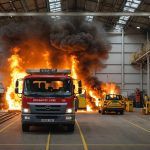Understanding Fire Safety Regulations in the UK
Navigating UK fire safety regulations is essential for any facility aiming for full compliance. The fire safety legislation in the UK is structured to protect property and lives, necessitating a clear understanding of local fire codes. These regulations outline comprehensive requirements for facilities to fortify themselves against fire hazards.
At the center of these regulations are a set of compliance standards that must be met, especially by manufacturing facilities. These standards aim to mitigate fire-related risks and amplify safety. For instance, the installation of adequate fire detection systems and accessible emergency escape routes form an integral part of these standards. Ensuring facilities are equipped with proper fire alarms and emergency lighting systems are just as crucial.
Also read : Launching your uk drone maintenance venture: the ultimate handbook for navigating aviation safety compliance
A critical aspect of understanding fire safety legislation is recognizing the importance of local statutory requirements. These requirements are intended to accommodate specific environmental and operational variables found in different locales. Compliance with these codes not only ensures that facilities remain within the bounds of the law but also fosters a safer working environment for all personnel involved. By adhering to these pivotal regulations, businesses not only demonstrate responsibility but also enhance their operational credibility and integrity.
Conducting a Comprehensive Fire Risk Assessment
A fire risk assessment is a critical procedure aimed at ensuring manufacturing plants are secure from fire hazards. This process involves identifying potential hazards and evaluating risk levels within the facility. Here’s how you can conduct an effective risk assessment:
Also to read : Kickstart your dream artisanal chocolate venture in the uk: essential insights for food safety compliance
-
Risk Identification: Begin by pinpointing areas where fires are likely to start. This includes places with electrical equipment, flammable materials, or processes involving high temperatures. Recognising such hazards is the first step to mitigating risks.
-
Hazard Evaluation: Once hazards are identified, evaluate their potential impact on both personnel and property. Determine the vulnerability of these areas, considering how easily a fire could spread and what factors might exacerbate the risk.
-
Preventive Measures: Develop strategies to mitigate identified risks. This might involve installing better ventilation, implementing stricter safety protocols, or increasing fire safety training for staff. Regularly updating these measures ensures they remain effective against evolving threats.
By systematically addressing these steps, facilities can improve their fire safety framework, ensuring compliance with institutional requirements and enhancing overall safety. Consistent monitoring and evaluation are key to sustaining these preventive measures and adapting to new challenges.
Implementing Mandatory Safety Equipment
In ensuring adherence to UK fire safety regulations, the installation of mandatory safety equipment plays a crucial role. Key components include fire alarms and emergency exits, both of which contribute significantly to a proactive safety management strategy.
Firstly, the installation and maintenance of fire alarms are vital for early detection and warning. Fire alarms must be strategically positioned to cover all areas without obstructions. Regular maintenance checks are essential to ensure functionality, thus preventing false alarms or failures during emergencies.
Emergency exits also form a critical part of compliance standards. These exits must be clearly marked and illuminated with appropriate signage. The pathways must remain unobstructed to facilitate a swift and orderly evacuation, crucial during a crisis. Moreover, the placement of emergency lighting is vital, particularly in larger facilities or those with complex layouts to guide personnel safely to exits in low-visibility situations.
Incorporating these safety measures within a fire safety policy ensures comprehensive preparedness. By establishing clear emergency exits and reliable fire alarm systems, facilities not only comply with statutory requirements but significantly minimise risks, thereby enhancing overall safety. Regular training for staff on the use of this equipment further reinforces the importance of these installations.
Developing a Fire Safety Policy
Creating a robust fire safety policy is pivotal for any facility aiming to foster a culture of safety and ensure compliance with UK fire safety regulations. This policy serves as a roadmap, outlining the necessary steps and protocols for effective safety management.
Key Elements of a Fire Safety Policy
-
Roles and Responsibilities: Clearly define responsibilities among personnel. This not only ensures accountability but also facilitates efficient emergency response. Each member of the team should understand their role within the compliance framework, from overseeing equipment maintenance to conducting drills.
-
Regular Reviews and Updates: It’s crucial to review and update fire safety policies. Regulations and technological advancements in fire safety solutions evolve, so the policy must reflect these changes. Regular reviews ensure the policy remains relevant and effective.
-
Comprehensive Safety Measures: The policy should encompass all areas of fire safety, including prevention, detection, and response. Incorporate regular safety management evaluations to identify weaknesses and proactively address potential fire hazards.
Conclusively, a well-structured fire safety policy not only aids in satisfying statutory demands but also elevates a facility’s dedication to safeguarding human life and property. This emphasis on policy development underscores the crucial role of planning and accountability in fire safety management.
Training Staff on Fire Safety Protocols
Ensuring comprehensive fire safety training for staff is crucial in maintaining a secure working environment. A well-structured training program covers all essential aspects of fire safety, from familiarising employees with emergency procedures to understanding their roles during crises.
Organising regular drills allows staff to practice and refine their response to potential fire emergencies. Drills should simulate real scenarios, aiding employees in responding promptly and correctly under pressure, which enhances their ability to act effectively should an actual incident occur.
Consistent employee education is vital to keep pace with evolving fire safety regulations. Regular training sessions on new safety measures equip staff with updated knowledge, ensuring continued compliance with relevant legislation. Not only does this raise awareness about the latest protocols, but it also fosters a proactive approach to safety.
It’s also important to emphasise specific actions required during emergencies, such as evacuation protocols and the use of fire safety equipment. This clarity ensures every team member knows how to contribute effectively to overall safety management.
By empowering employees with thorough training, organisations can cultivate a culture of safety awareness, which is integral to any effective fire safety strategy.
Establishing Ongoing Compliance Monitoring
Incorporating ongoing compliance monitoring mechanisms into a facility’s safety strategies is vital for maintaining effective fire safety standards. Regular fire safety audits are a fundamental component of this process, providing a structured approach to evaluate and enhance current safety measures.
To execute effective audits, facilities should develop comprehensive checklists. These checklists serve as invaluable tools for systematically ensuring that all relevant safety regulations are met. Items typically include checking the functionality of fire alarms, validating the clarity of emergency exits, and confirming the adherence to all statutory requirements.
Implementing feedback loops forms another crucial aspect of sustaining compliance. By collecting and analysing data from audits, facilities can identify areas needing improvement and make necessary adjustments. This process not only ensures the rectification of existing issues but also acts as a preventive measure against potential hazards.
Strategies like these not only promote continuous improvement in fire safety practices but also enhance the facility’s adaptability to emerging challenges and regulations. By establishing a robust system of compliance monitoring, manufacturing plants can uphold high levels of safety, reducing risks and reinforcing their commitment to protecting both assets and personnel.
Case Studies of Successful Fire Safety Compliance in Manufacturing
Exploring manufacturing case studies sheds light on successful compliance strategies and best practices. By examining real-world examples, manufacturers can gain insights into the effective implementation of fire safety measures.
One notable case involved a large manufacturing plant in Sheffield, which achieved successful compliance by incorporating key strategies. This facility prioritised the comprehensive training of personnel and ensured regular fire drills, reinforcing the importance of preparedness and quick response during emergencies. By making education a cornerstone of their fire safety policy, they significantly reduced risks.
Another example is a mid-sized plant in Manchester, which excelled by focusing on fire safety audits. Routine inspections using detailed checklists helped the facility address potential hazards proactively. They implemented feedback loops to make continuous improvements, ensuring all safety measures were up-to-date with current regulations.
These best practices have informed lessons vital for other manufacturers aiming for compliance. Regular audits, staff training, and adopting a proactive approach to risk management emerged as key elements. By integrating these strategies, facilities can enhance their safety preparedness, mitigate fire-related risks, and maintain high compliance standards. Adopting such practices positions a facility as both responsible and committed to safeguarding its personnel and operations.











